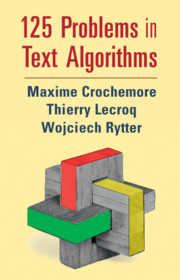47 results
9 - Multivariate Data Exploration and Discrimination
-
- Book:
- A Practical Guide to Data Analysis Using R
- Published online:
- 11 May 2024
- Print publication:
- 30 May 2024, pp 400-468
-
- Chapter
- Export citation
The relative clause resisting unification
-
- Journal:
- Canadian Journal of Linguistics/Revue canadienne de linguistique , First View
- Published online by Cambridge University Press:
- 13 May 2024, pp. 1-11
-
- Article
- Export citation
Constrained read-once refutations in UTVPI constraint systems: A parallel perspective
-
- Journal:
- Mathematical Structures in Computer Science / Volume 34 / Issue 3 / March 2024
- Published online by Cambridge University Press:
- 11 September 2023, pp. 227-243
-
- Article
-
- You have access
- Open access
- HTML
- Export citation
13 - School Matching and Learning under the Influence of Intergenerational Advice
- from Part V - Advice and Economic Mechanisms
-
- Book:
- Advice, Social Learning and the Evolution of Conventions
- Published online:
- 09 March 2023
- Print publication:
- 09 March 2023, pp 360-393
-
- Chapter
- Export citation
12 - Chatting and Matching
- from Part V - Advice and Economic Mechanisms
-
- Book:
- Advice, Social Learning and the Evolution of Conventions
- Published online:
- 09 March 2023
- Print publication:
- 09 March 2023, pp 321-359
-
- Chapter
- Export citation
Glucose promotes controlled processing: Matching, maximizing, and root beer
-
- Journal:
- Judgment and Decision Making / Volume 5 / Issue 6 / October 2010
- Published online by Cambridge University Press:
- 01 January 2023, pp. 450-457
-
- Article
-
- You have access
- Open access
- HTML
- Export citation
Effects of crop insurance on farm input use: Evidence from Kansas farm data
-
- Journal:
- Agricultural and Resource Economics Review / Volume 51 / Issue 2 / August 2022
- Published online by Cambridge University Press:
- 06 May 2022, pp. 361-379
-
- Article
-
- You have access
- Open access
- HTML
- Export citation
Raising and matching in Pharasiot Greek relative clauses: A diachronic reconstruction
-
- Journal:
- Journal of Linguistics / Volume 58 / Issue 3 / August 2022
- Published online by Cambridge University Press:
- 21 December 2021, pp. 495-533
- Print publication:
- August 2022
-
- Article
- Export citation
A stochastic matching model on hypergraphs
- Part of
-
- Journal:
- Advances in Applied Probability / Volume 53 / Issue 4 / December 2021
- Published online by Cambridge University Press:
- 22 November 2021, pp. 951-980
- Print publication:
- December 2021
-
- Article
- Export citation
3 - Pattern Matching
-
- Book:
- 125 Problems in Text Algorithms
- Published online:
- 10 June 2021
- Print publication:
- 01 July 2021, pp 53-110
-
- Chapter
- Export citation

125 Problems in Text Algorithms
- with Solutions
-
- Published online:
- 10 June 2021
- Print publication:
- 01 July 2021
Combining Outcome-Based and Preference-Based Matching: A Constrained Priority Mechanism
-
- Journal:
- Political Analysis / Volume 30 / Issue 1 / January 2022
- Published online by Cambridge University Press:
- 08 March 2021, pp. 89-112
-
- Article
-
- You have access
- Open access
- HTML
- Export citation
Do Overseas Returnees Excel in the Chinese Labour Market?
-
- Journal:
- The China Quarterly / Volume 247 / September 2021
- Published online by Cambridge University Press:
- 19 February 2021, pp. 875-897
- Print publication:
- September 2021
-
- Article
- Export citation
On the Use of Two-Way Fixed Effects Regression Models for Causal Inference with Panel Data
-
- Journal:
- Political Analysis / Volume 29 / Issue 3 / July 2021
- Published online by Cambridge University Press:
- 12 November 2020, pp. 405-415
-
- Article
- Export citation
6 - Regular Expressions
-
- Book:
- Python for Linguists
- Published online:
- 20 April 2020
- Print publication:
- 07 May 2020, pp 117-137
-
- Chapter
- Export citation
8 - Muddied waters: The challenge of confounding
-
- Book:
- Essential Epidemiology
- Published online:
- 31 August 2020
- Print publication:
- 29 November 2019, pp 185-209
-
- Chapter
- Export citation
Assessing the computational complexity of multilayer subgraph detection
-
- Journal:
- Network Science / Volume 7 / Issue 2 / June 2019
- Published online by Cambridge University Press:
- 05 August 2019, pp. 215-241
-
- Article
- Export citation
3 - Topological connectedness and independent sets in graphs
-
-
- Book:
- Surveys in Combinatorics 2019
- Published online:
- 17 June 2019
- Print publication:
- 27 June 2019, pp 89-114
-
- Chapter
- Export citation
Why Propensity Scores Should Not Be Used for Matching
-
- Journal:
- Political Analysis / Volume 27 / Issue 4 / October 2019
- Published online by Cambridge University Press:
- 07 May 2019, pp. 435-454
-
- Article
- Export citation
The structure of priority in the school choice problem
-
- Journal:
- Economics & Philosophy / Volume 35 / Issue 3 / November 2019
- Published online by Cambridge University Press:
- 24 January 2019, pp. 361-381
-
- Article
- Export citation










